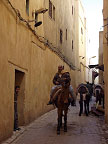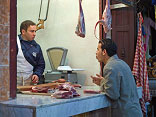FRANKFURT | CASABLANCA | ROAD TO FEZ | FEZ | ROAD TO ERFOUD | ONWARD TO OUARZAZATE | ROAD TO MARRAKECH | MARRAKECH | TUNISIA | CARTHAGE | DOUGGA/BULLA REGIA | DUBAI | AL MAHA | OMAN | SALALAH |
FEZA magnificent day. We walked and walked and walked through the Old City of Fez (founded in the 1200's). I continue to be amazed at how compact (i.e. crowded) people were/are willing to live. You either love your neighbor or you move. The distance between most buildings in the Old City is less than three feet. The medina is a mix of homes and shops. Everything is accessed through an outer wide or narrow alley. The typical house is tiny. The outer doorway from the public passageway to the home is a foot lower in height than the second doorways inside that go into the living quarters. This is both to help with heat and cooling and to insure that the people entering the house are forced to slightly bow before entering. Hassan, our guide, explained that the family is so central and important in Morocco that the architectural device of a low-clearance doorway requiring a moderate bow reminded everyone that the family must be treated with an attitude approaching reverence. The distance between most buildings in the Old City is less than three feet. The medina is a mix of homes and shops. Everything is accessed through an outer wide or narrow alley. The typical house is tiny. The outer doorway from the public passageway to the home is a foot lower in height than the second doorways inside that go into the living quarters. This is both to help with heat and cooling and to insure that the people entering the house are forced to slightly bow before entering. Hassan, our guide, explained that the family is so central and important in Morocco that the architectural device of a low-clearance doorway requiring a moderate bow reminded everyone that the family must be treated with an attitude approaching reverence.
The alleyways that lead to the houses are linked by "streets" where the merchants trade. Although the area feels like a maze, there is logic to the system. The quarter is divided into districts. Each district has a public baker (for bread, which  clients bring in as raw dough), a public bath, a mosque, a kindergarten (and one other service which we've forgotten but will mention tomorrow). The streets are shared with people walking, donkeys. A mini-caravan of donkeys carrying wool or hides to be talking, carrying goods to and fro, carts, and processed makes for a tight fit on some streets. Each of the houses is said to have indoor plumbing and running water. But they don't have refrigeration. SO shopping is an everyday affair. Fast food is another story. Meat is preserved by drying. Then it is coated in salt, followed by encasement in fat. This is a potentially great thing to eat if you are up to your eyeballs in snow but a bit heavy for a Mediterranean climate. To make it for a meal, one fries it. Hassan said it's possible to make a ten minute main dish by using some of this preserved meat, adding veggies, and giving it a quick cook. Just the thing for unexpected guests. clients bring in as raw dough), a public bath, a mosque, a kindergarten (and one other service which we've forgotten but will mention tomorrow). The streets are shared with people walking, donkeys. A mini-caravan of donkeys carrying wool or hides to be talking, carrying goods to and fro, carts, and processed makes for a tight fit on some streets. Each of the houses is said to have indoor plumbing and running water. But they don't have refrigeration. SO shopping is an everyday affair. Fast food is another story. Meat is preserved by drying. Then it is coated in salt, followed by encasement in fat. This is a potentially great thing to eat if you are up to your eyeballs in snow but a bit heavy for a Mediterranean climate. To make it for a meal, one fries it. Hassan said it's possible to make a ten minute main dish by using some of this preserved meat, adding veggies, and giving it a quick cook. Just the thing for unexpected guests.
 We spent the whole day looking at areas that were built in the eighth, twelveth, fourteenth and twentieth centuries. The most interesting, as it has been in every country we have been to, is the interaction of the local merchants with their everyday customers. The more we see those patterns, the more the world seems to turn on that fundamental link of everyday interaction. We spent the whole day looking at areas that were built in the eighth, twelveth, fourteenth and twentieth centuries. The most interesting, as it has been in every country we have been to, is the interaction of the local merchants with their everyday customers. The more we see those patterns, the more the world seems to turn on that fundamental link of everyday interaction.
|
|
| TURKEY AND GREECE | CIRCLE THE ARCTIC |